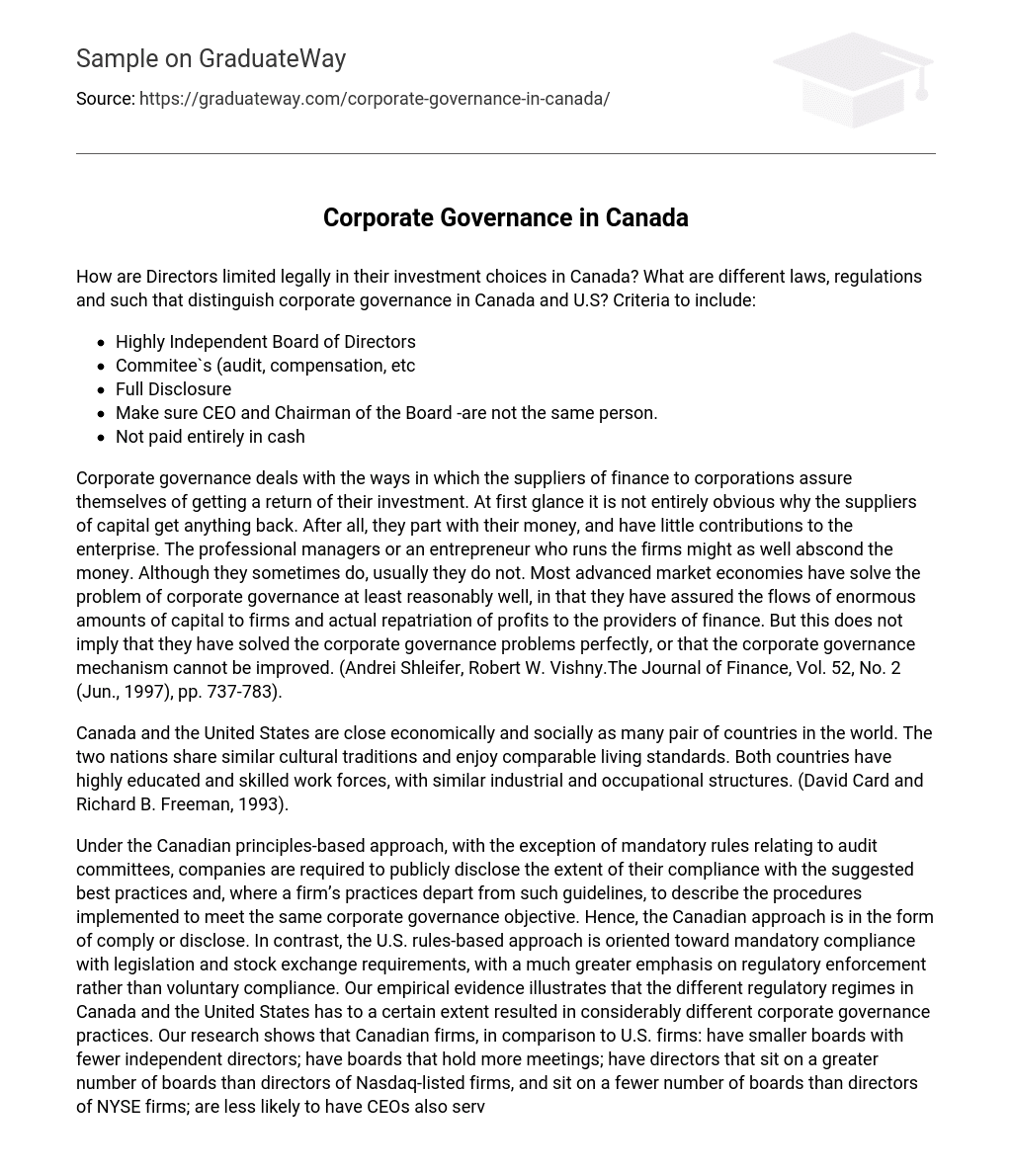How are Directors limited legally in their investment choices in Canada? What are different laws, regulations and such that distinguish corporate governance in Canada and U.S? Criteria to include:
- Highly Independent Board of Directors
- Commitee`s (audit, compensation, etc
- Full Disclosure
- Make sure CEO and Chairman of the Board -are not the same person.
- Not paid entirely in cash
Corporate governance deals with the ways in which the suppliers of finance to corporations assure themselves of getting a return of their investment. At first glance it is not entirely obvious why the suppliers of capital get anything back. After all, they part with their money, and have little contributions to the enterprise. The professional managers or an entrepreneur who runs the firms might as well abscond the money. Although they sometimes do, usually they do not. Most advanced market economies have solve the problem of corporate governance at least reasonably well, in that they have assured the flows of enormous amounts of capital to firms and actual repatriation of profits to the providers of finance. But this does not imply that they have solved the corporate governance problems perfectly, or that the corporate governance mechanism cannot be improved. (Andrei Shleifer, Robert W. Vishny.The Journal of Finance, Vol. 52, No. 2 (Jun., 1997), pp. 737-783).
Canada and the United States are close economically and socially as many pair of countries in the world. The two nations share similar cultural traditions and enjoy comparable living standards. Both countries have highly educated and skilled work forces, with similar industrial and occupational structures. (David Card and Richard B. Freeman, 1993).
Under the Canadian principles-based approach, with the exception of mandatory rules relating to audit committees, companies are required to publicly disclose the extent of their compliance with the suggested best practices and, where a firm’s practices depart from such guidelines, to describe the procedures implemented to meet the same corporate governance objective. Hence, the Canadian approach is in the form of comply or disclose. In contrast, the U.S. rules-based approach is oriented toward mandatory compliance with legislation and stock exchange requirements, with a much greater emphasis on regulatory enforcement rather than voluntary compliance. Our empirical evidence illustrates that the different regulatory regimes in Canada and the United States has to a certain extent resulted in considerably different corporate governance practices. Our research shows that Canadian firms, in comparison to U.S. firms: have smaller boards with fewer independent directors; have boards that hold more meetings; have directors that sit on a greater number of boards than directors of Nasdaq-listed firms, and sit on a fewer number of boards than directors of NYSE firms; are less likely to have CEOs also serving as the chairman of the board; and are less likely to have compensation, nominating and corporate governance committees, and the fraction of independent directors sitting on these committees is significantly lower. We conclude that there are pros and cons associated with both the principles-based and rules-based regimes. The extent to which the made-in-Canada approach to governance is found to be effective largely depends upon whether investors remain confident in regulation of the Canadian capital markets. (KAI LI University of British Columbia – Sauder School of Business ERINN B. BROSHKO Farris, Vaughan, Wills & Murphy LLP February 2006)
The proposed rules recognize the critical role played by audit committees in the financial reporting process and the unique position of audit committees in assuring auditor independence. As directed by section 208(a) of the Sarbanes-Oxley Act of 2002, we are proposing rules to: Revise the Commission’s regulations related to the non-audit services that, if provided to an audit client, would impair an accounting firm’s independence; define the circumstances whereby an issuer’s audit committee can and should pre-approve all audit and allowable non-audit services provided to the issuer by the auditor of an issuer’s financial statements; prohibit partners on the audit engagement team from providing audit services to the issuer for more than five consecutive years; prohibit an accounting firm from auditing an issuer’s financial statements if certain members of management of that issuer had been members of the accounting firm’s audit engagement team within the one-year period preceding the commencement of audit procedures; and require that the auditor of an issuer’s financial statements report certain matters to the issuer’s audit committee, including “critical” accounting policies used by the issuer.
The Board of Directors are:
(Chair of the Board) Dr. Gary Kachanoski, Vice-President, Research, for the University of Alberta, and Professor in the Department of Renewable Resources
(vice-Chair) Allan Scott, President & CEO of EEDC, former partner in Riverview Venture Partners and President and COO of EdTel and then Telus
Richard L. Casey, former Chairman and CEO of Scios Inc., former Executive Vice-President for ALZA Corporation, and GM for Syntex Corporation
Nancy Harrison, former Senior Vice-President for Ventures West Management Inc. Bruce Johnson, retired President of Intuit Canada and Intuit UK
Wayne Karpoff, Co-founder and CTO of YottaYotta Inc., Founding chair of the Alberta ICT Council and co-chair of the Digital Solutions Alliance.
Chris Lumb, President & CEO, Micralyne Inc., Chair of the Board of Directors of CMC Microsystems, and on the Board of Trustees of the National Institute of Nanotechnology Robert Teskey, Managing Partner with FieldLaw Doug Maley, Assistant Deputy Minister, Western Economic Diversification Canada
Dr. David Cox, CEO, TEC Edmonton, former President and CEO of Quest PharmaTech Inc., CEO of Apotex Fermentation Inc., Synsorb Biotech Inc. and KS Avicenna Inc





